Space exploration: the return to the Moon Understand article
Have you ever looked up at the Moon in a clear night sky and wondered about the very few people who have walked on its surface? What did we learn, and what are we still unsure about? When might humans return to the Moon? Adam Baker investigates.
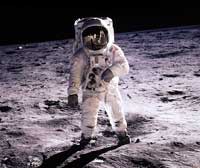
photographs showing Neil
Armstrong on the Moon (he
carried the camera most of
the time). He is reflected in
Buzz Aldrin’s visor
Image courtesy of NASA
In 1969, Neil Armstrong and Buzz Aldrin became the first humans to walk on the surface of another astronomical body: the Moon. Over the next three years, ten more American astronauts landed on the Moon as part of the USA’s Apollo programme. Since then – nearly 40 years ago – there have been no further manned missions to the Moon. Why is that? And when might people return to the Moon?
In the 1960s and 70s, the Apollo programme and the unmanned Russian Luna and US Surveyor missions concentrated on the surface of the near side of the Moon and left many key questions unanswered, in particular:
- The age of the Moon and how this is linked to the age of the rest of the Solar System. The rocky surface of the Moon is key to this research: although we can study the Earth more easily, its surface has been altered by weathering, whereas the surface of the Moon has remained more or less unchanged since its formation.
- The overall chemical composition and internal structure of the Moon. This will start to tell us how the Moon originated, and whether it formed from bits of Earth debris, as some theories claim.
- Whether resources such as water are available on the Moon, which would enable astronauts to use the Moon as a base for exploring other planets.
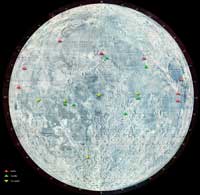
that have landed on the
moon. Green triangles
represent Apollo missions,
yellow are NASA Surveyor
missions, and red are
Russian Luna spacecraft.
Click to enlarge image
Image courtesy of National
Space Science Data Center /
NASA’s Goddard Space Flight
Center
Today, space technology is seen as mostly addressing problems on Earth, such as climate change; the European Space Agency (ESA), for example, has launched many satellites to observe the Earth’s atmosphere, oceans and ice capsw1. Nonetheless, after years of inaction in lunar exploration, the past decade has again seen many countries sending missions to the Moon.
In 2003, ESA sent the robotic (unmanned) Smart-1 missionw2 to orbit the Moon, to test technology for sending missions accurately beyond Earth’s orbit, and to conduct basic science such as X-ray observations of the Moon. Shortly afterwards, ESA also launched the Mars Express mission, its first mission to orbit another planet, with a package of scientific instruments. These missions marked the reawakening of interest in space exploration.
In the USA in 2004, President George W Bush directed NASA to return to the Moon and build a long-term outpost on the lunar surface as part of his vision for space explorationw3. Subsequently, a global exploration strategyw4 was agreed between 14 space agencies and organisations, encompassing the US vision, as well as space exploration plans from other countries such as the UKw5.
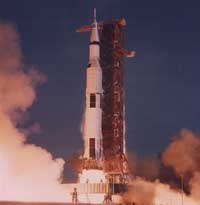
Image courtesy of NASA
Kennedy Space Center
(NASA-KSC)
September 2007 saw the launch of the Japanese Kaguya orbiter mission (originally known as Selene). While orbiting the Moon’s surface, it searched (unsuccessfully) for water on the lunar surface, measured the strength of the lunar gravitational field using a small satellite, and studied the chemistry of the lunar surface. Kaguya also imaged the lunar surface in visible wavelengths, generated maps of much of the surface, and measured the radiation in orbit to assess the risk to future astronauts.
The Chinese orbiter Chang’e-1, launched a month later, also studied the topography and chemistry of the lunar surface and searched for water. Little data from Chang’e-1 has been released to the international community, however.
In April 2008, the Indian Chandrayaan-1 orbiter was launched to address many of the same questions as the Kaguya orbiter. Additionally, Chandrayaan-1 carried a radar instrument, allowing scientists to peer into dark craters near the lunar poles for the first time. These radar measurements suggested that water ice was present at the lunar south pole. This was confirmed in 2009 when the US LRO orbiter fired a rocket, the LCROSS impactor, into a south pole crater: instruments on the orbiter detected evidence of water ice in the particles that were thrown into space by the crashw6, w7. Data from the LRO orbiter even showed where – 37 years before – a Russian lunar rover had come to restw8.
These recent missions, therefore, have gone some way to addressing the questions left unanswered in the 1970s, providing information about the chemical composition of more of the Moon’s surface, and hinting at the presence of water and other resources that might be found at the cold, dark south pole (below 100 K). More information is still to come – some of the extensive maps generated by Japanese, Chinese, Indian and American orbiters are still being processed.
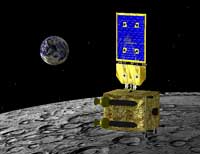
orbiter has four penetrators
– small daughter spacecraft
to be fired into the Moon’s
surface
Image courtesy of SSTL
However, to fully understand the nature of the Moon and its environment – and potentially to prepare for people to visit and stay safely on the Moon for long periods, making astronomical observations, investigating the lunar geology, preparing for more distant space exploration or even mining lunar resources – we need information that even these recent missions, orbiting far above the Moon’s surface, cannot answer. What, for example, is the effect of lunar dust on people, vehicles and telescopes? Can we survive on the Moon for periods as long as several weeks? What new technology, such as power sources and thermal insulation, is needed to help astronauts survive comfortably when working in the dark, extremely cold lunar polar craters?
The answers to these questions will require landers – robots to land on the surface of the Moon and directly measure the properties of dust, rock and the lunar environment (such as moonquakes) over extended periods. Unlike the unmanned missions of the 1960s and 70s, future lander missions would need to investigate the entire lunar surface, carrying out scientific studies, seeking the best places to build bases and transmitting the data directly back to Earth via radio links.
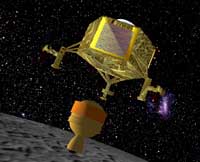
lander would give accurate
indications of the age of the
Moon, sampling regions
which no mission has yet
visited
Image courtesy of SSTL
Already, such missions are being planned. China and India intend to follow their recent orbiter missions with robotic landers (Chang’e-2 and Chandrayaan-2, respectively). To build on these and other lunar missions and to cover a larger portion of the unexplored lunar surface, the UK is developing small, low-cost spacecraft. With their automated guidance systems and miniaturised instruments, these spacecraft would enable regular, inexpensive, small missions to the Moon – starting as early as 2014. With the support of ESA, other European nations are also studying advanced lunar landersw9. These will carry a wide range of technologies and can test systems suitable for carrying astronauts and for future Mars expeditions, but will be larger and more costly, and are not fully funded yet.
Although the US vision for space exploration – with a manned lunar base by 2020 – sounds exciting, NASA and the US government have recently decided that their plans are unaffordable. Instead, it will be robotic lunar missions that characterise the lunar environment and map available resources, providing a logical, faster and more affordable route to a sustained presence on our nearest neighbour. Although it will probably be some time before the 13th human lands on the Moon, robotic missions are key to bringing that day ever closer. This is a lasting legacy of Apollo.
References
- Hodge R (2006) The sky’s the limit. Science in School 1: 70-71. www.scienceinschool.org/2006/issue1/baker
Web References
- w1 – To learn more about the European Space Agency’s earth observation programme, including the CryoSat-2 ice satellite to study the effects of global warming, see: www.esa.int/esaEO
- w2 – To learn more about ESA’s Smart-1 mission, see: www.esa.int/SPECIALS/SMART-1
- w3 – To learn more about the US vision for space exploration, see: http://history.nasa.gov/sep.htm
- w4 – For more information about the global exploration strategy, see: www.globalspaceexploration.org
- w5 – The 2007 report of the UK space exploration working group can be downloaded from the UK Space Agency website (www.bnsc.gov.uk) or via the direct link: http://tinyurl.com/3xe8vr7
- w6 – To read the article ‘NASA ‘ecstatic’ after LCROSS impact reveals water on moon’, see The Guardian website (www.guardian.co.uk) or use the direct link: http://tinyurl.com/ylmb6pm
- w7 – For more information about the LRO mission, see: http://lunar.gsfc.nasa.gov
- w8 – To learn more about the recently discovered Russian lunar rover, see the Science Daily website (www.sciencedaily.com) or use the direct link: http://tinyurl.com/yfbzjcv
- w9 – ESA is inviting industry to submit proposals for a lunar lander mission. For more details, see the ESA website (www.esa.int) or use the direct link: http://tinyurl.com/2utzaq7
- w10 – Surrey Satellite Technology specialises in designing, building and launching small satellites. See: www.sstl.co.uk
Resources
- For more information about the Apollo programme, see:
- Flightglobal’s website devoted to Apollo missions: www.flightglobal.com/page/Apollo-40th-Anniversary
- A video commemorating the 40th anniversary of the first walk on the moon: www.youtube.com/watch?v=oXxGE4tBBEA
- NASA’s archive for lunar mission data: http://nssdc.gsfc.nasa.gov/planetary/lunar
- To mark the 40th anniversary of the Moon landings, BBC Radio 4 presented the story of the British MoonLITE project and the lunar ambitions and achievements of the other space-exploring nations. See: www.bbc.co.uk/programmes/b00lnycv
Review
The space exploration race of the 1960s was a very exciting period and important in the development of a number of technologies; the Moon landings were a major highlight. After a gap of several decades, people are again planning to explore the Moon – this article considers how and why.
The article could be used as the starting point of discussions in science or technology lessons, for example on the history of science. It could also be used in science clubs or similar activities.
Eric Deeson, UK





